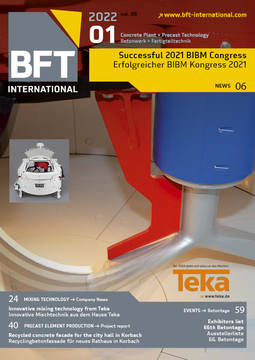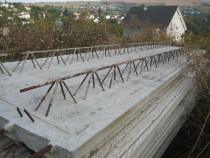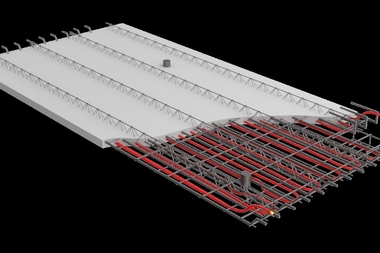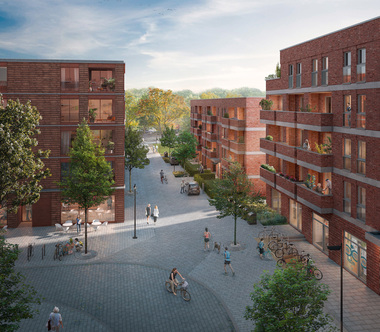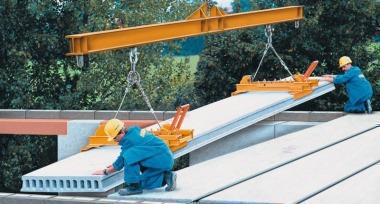Leipzig heat transition with Heidelberg concrete elements
With the erection of the heating power station (HWK) on Bornaische Street, the public utility Leipziger Stadtwerke has reached an important milestone on the road to climate-neutral energy supply for the city of Leipzig, Germany. The new power station operates with gas turbines that, in the future, can be converted to renewable energies. The precast concrete constructions for the power station, the gas plant and the pump hall were planned, delivered and also partly erected by Heidelberger Betonelemente GmbH & Co. KG. A total of approx. 1,450 m³ precast components with individual weights of up to 40 tons were delivered and erected, among them:
1,800 m² precast prestressed concrete floor slabs
3,350 m² floor slabs and
2,270 m² double wall elements.
The new gas-fired turbine power station is scheduled to be put into service in late 2022 and from there on to supply the city of Leipzig with electric power and heat and at the same time enabling an exit from brown coal. In this way, the construction of one of the most modern heating station of the world is underway in Leipzig, aimed at becoming Germany’s first climate-neutral large-scale power station based on renewable energies and, more specifically, on green hydrogen. The entire power station consists of four buildings: the power plant, the heat storage plant, the gas plant and the pump hall, which will be connected over a pipeline bridge.
The company Glass Ingenieurbau Leipzig GmbH is responsible for the unfinished building works, the earth works and the special underground works. In order to be able to erect the buildings on the existing subsoil, a drilled-pile foundation was necessary. The drilled piles are able to distribute the heavy loads into the subsoil. Their installation is nearly free from vibration. The subsoil was thoroughly analyzed before drilling the test piles, and its settlement behavior was just as thoroughly recorded afterwards. From mid-2020 to the end of 2020, around 400 piles were installed down to depths of 30 m. The foundation and the ground slabs were cast in-situ. The foundation level provides the base for the support columns. “The supporting columns, which are precast, are up to 24 m high and weigh up to 22 tons. That requires work with millimeter precision to enable the mobile crane to position the columns correctly, and to ensure subsequent precision bolting,” reports General Site Manager for Superstructure Löbel at Glass Ingenieurbau.
The heating power station Leipzig Süd depends on an energy mix
In Germany, Heidelberger Betonelemente specializes in the development of system solutions for building with precast concrete elements. Heiko Schulzki of Heidelberger Betonelemente explains: “We have also taken on part of planning, in which we had to consider many details – since it was necessary to adjust the buildings to the complex technical equipment. We used our complete range of precast and semi-precast elements. But this was primarily columns, prestressed concrete beams and solid wall elements of concrete grade C25/30 to C40/50. All of the precast elements are individually manufactured for this construction project, with the result that every element is one of a kind.”
The roof beams, with a span of 25 m and cross-sections of up to 1.40 m, are reinforced with prestressing strands to enable the long spans. The beams have individual weights of up to 45 tons and were erected with a 750-ton crane. Andreas Löbel supplements: “Heidelberger Betonelemente has intensively supported us in detail planning. The entire precast construction of the building was modelled in 3-D and the construction sequence coordinated element by element with the company Glass.” By now, all columns are in place and the precast walls and the floor construction closed with prestressed concrete beams. The power station is equipped with two lines with gas turbines and hot water generators. The stack of the hot water generator marks the final height of the power FFstation of 54 m. The heat storage plant will reach a building height of as much as 60 m and will become the landmark of the city of Leipzig. .
Work on the construction site of power station HWK Leipzig Süd is exactly on time: not least owing to the use of precast concrete elements. Because their deployment on site can be exactly scheduled, this enables fast and easy erection of work by the individual trades and downstream works. This substantially increases the efficiency and the construction process on the entire site.
Within the scope of the future concept of district heating, Stadtwerke Leipzig, with its core element consisting of the power station Leipzig Süd, will invest more than 300 million euros in the construction of new facilities. As a result of these investments in environmentally friendly and innovative facilities, the Leipzig utility will achieve greater efficiency and generate less C02 emission.
CONTACT
Heidelberger Betonelemente GmbH & Co.KG
Berliner Straße 6
69120 Heidelberg/Germany
+49 6221 481-0




